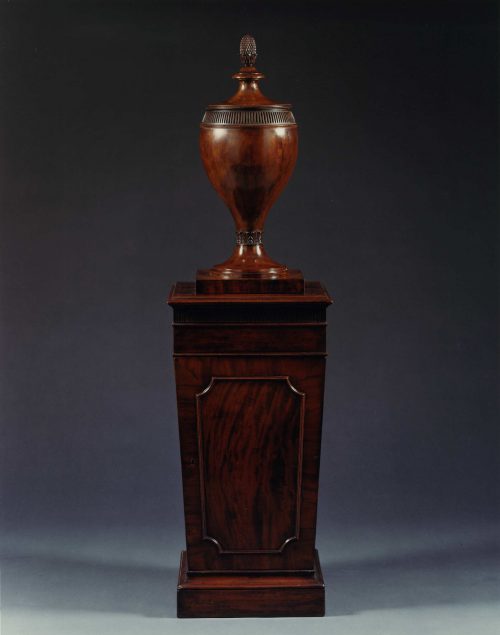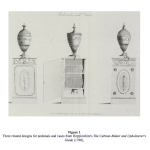9151 A FINE PAIR OF GEORGE III MAHOGANY PEDESTALS AND URNS RETAINING THEIR ORIGINAL FITTINGS English. Circa 1780. Measurements: Height: 68″ (173 cm) Width: 19 1/4″ (49 cm) Depth: 18″ (46 cm)

-
Figure 1
-
Figure 2
-
Figure 3
Research
Of mahogany. Each with a pinecone finial surmounting a shaped and molded lid, the lid set on an unusually shaped vase with a fluted frieze and acanthus leaf collar, the urn raised on a tapering paneled base with molded edge above a fluted frieze, the frieze above a single drawer, the drawer to one pedestal fitted with lidded containers for tea, the drawer to the other pedestal lined with lead, each pedestal set on a plain plinth with a molded edge.
Provenance:
Formerly in the collection of Sir James Walker
Included in M. Harris and Son, A Catalogue and Index of English Furniture, Part III, London (1932), p. 393
In the 18th century, side tables employed in the dining room were not yet themselves equipped with storage spaces, but were used in conjunction with separate pedestals. Such sideboard-pedestals, topped with urns or vases, appeared in dining rooms circa 1760 and provided additional utility and storage. Plate warmers and cellarettes could be found in the bases, along with iron stands and heaters, while the urns were used for holding iced water, or water for rinsing the silver.1 It was customary to wash glasses and cutlery during dinner even into the early 19th century, as evidenced by mention of the practice in George Smith’s Household Furniture (1808).2
Sideboard-pedestals and urns were typically constructed in the same material, and of the same design, as the sideboards which they flanked, and “afforded an opportunity for accomplished classical design,”3 perfected by leading cabinetmakers of the day, namely Robert Adam, Thomas Chippendale and George Hepplewhite. Figure 1 depicts three designs for pedestals and vases from Hepplewhite’s The Cabinet-Maker and Upholsterer’s Guide (1788), which exhibit similarities in shape to the present pair. The Guide recommended that pedestals be made to the same height as the sideboard, and sixteen to eighteen inches square, however earlier examples from the Adam period, particularly those by Chippendale, were made with lower pedestals and taller urns.4
Of traditional Georgian form, the present pedestals and urns are embellished with neoclassical details. The urns are topped by pine cone finials, symbolic of the thyrsic wand of Dionysus, with fluted friezes and acanthus leaf collars, elements of ancient architectural design. By the 19th century mahogany was generally employed as the preferred material, as seen on a pedestal and urn from Syon house, circa 1815, whose decoration, like the present pair, is far more restrained than earlier examples (figure 2).
The present pedestals and urns were published together with a mahogany sideboard of similar date in M. Harris and Son’s A Catalogue and Index of English Furniture, Part III (figure 3), and were formerly in the collection of Sir James Walker. The Walker family of Sand Hutton, Yorkshire, rose to prominence as landed gentry in the late 18th century. The baronetcy was created on 9 December 1868 for James Walker, a Justice of the Peace, Deputy Lieutenant of Yorkshire, and High Sheriff. The second Baronet, his son, was a Member of Parliament for Beverley.
Footnotes:
1. Edwards, Ralph, ed. The Dictionary of English Furniture, Volume III. Suffolk: The Antique Collector’s Club Ltd., 1954. 138.
2. Smith, George. A Collection of Designs for Household Furnishings and Interior Decoration. London: J. Taylor, 1808. 17.
3. Edwards, 138.
4. Musgrave, Clifford. Adam and Hepplewhite and Other Neo-Classical Furniture. London: Faber and Faber, 1966. 140.




Comments are closed.